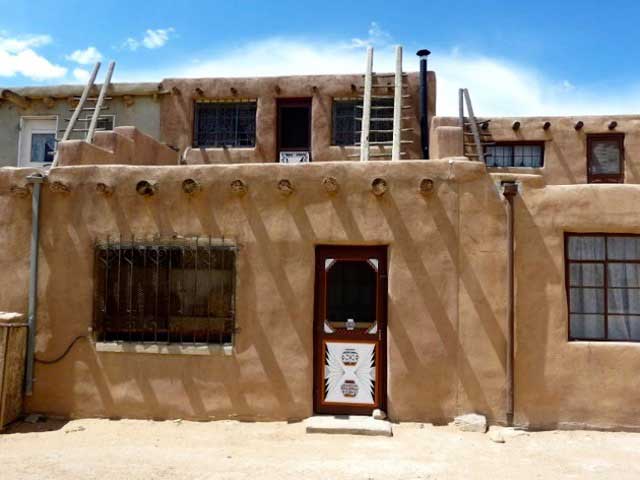

Among the many traditions handed down from New Mexico’s first people, the most visible is the adobe pueblo home. Nowhere is there a better example of this ancient way of life than at Acoma Pueblo (acomaskycity.org), 60 miles west of Albuquerque, New Mexico.
Acoma Pueblo
Some 1,500 years ago, certain tribes settled in the area around Albuquerque and Santa Fe in the northwestern part of the state that is now called “Indian Country.” These groups, archaeologists say, are descendants of prehistoric Indians who wandered throughout the southwest from 12,000 to 30,000 years ago.
The Acoma men would dry farm, relying solely on the rain for prosperous vegetation. They would hunt in the reservation valleys and mountains for wildlife (rabbits, turkey, deer, antelope) for survival.
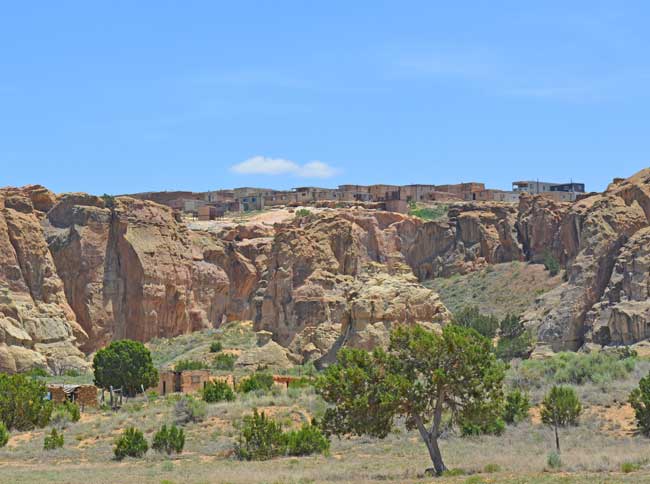
Sky City
Here, atop a sun-baked mesa 367 feet above the valley floor, sits the “oldest continuously inhabited” community in North America.
Dubbed “Sky City,” the village dates back more than 1,000 years. About 10 to 13 families live on the mesa year-round. Most live in other reservation villages to the north and return for ceremonial events.
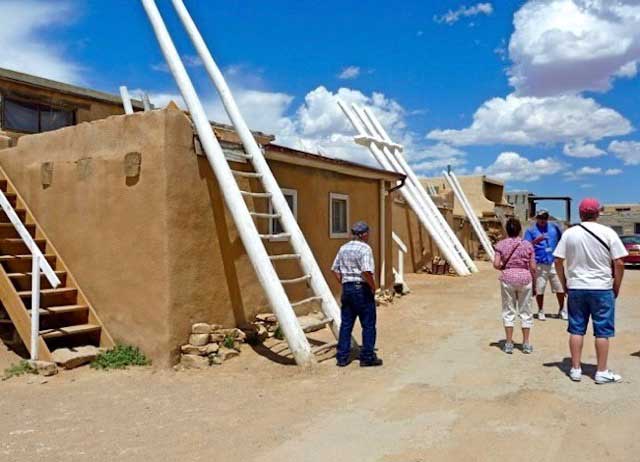
About 300 structures fashioned from traditional mud bricks and sandstone (adobe) make up the community. Female tribe members own the flat-roof homes, none of which have running water, sewer or electricity. A lineup of portable potties along a road is a reminder of the primitive conditions.
One home has a sign that reads: “Beware of falling wall in this area.” Some of the homes, however, appear to have been refurbished with newer windows and doors. The Acoma people use propane lanterns and oil lamps for lighting and haul water from a nearby spring up to the mesa top in water containers. They cook and heat their houses with wood stoves.
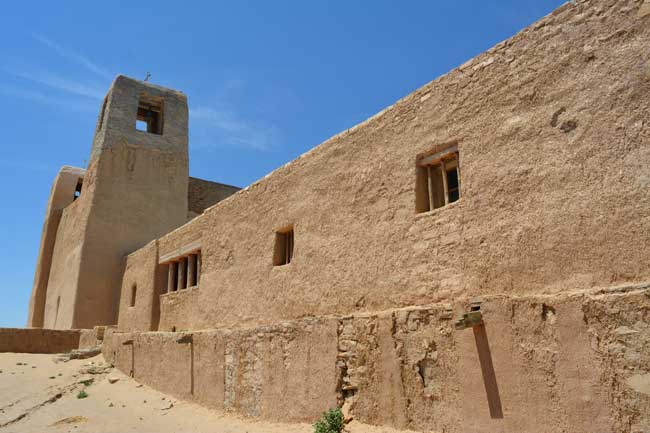
San Esteban del Rey Mission
The highest building is San Esteban del Rey Mission, a Catholic church completed in 1629 after a long battle between the Native Americans and the Spanish conquerors who forced Catholicism by inhuman acts of oppression for more than 100 years.
Today, the natives are comfortable practicing a combination of their ancestral tribal traditions with Catholic teachings.
The Mission, one of the oldest in the nation, looms large above the cemetery of Sky City. The spacious 21,000 square-foot adobe structure was built by the Acoma people during a time when access to the mesa from the valley was only by climbing foot holes in the rock.
Inside, a dirt floor leads up a flight of stairs to the altar. Stations of the Cross in Spanish decor from 1770 adorn the 10-foot thick walls, where some say bodies are buried. The mission is used only for Christmas Eve mass, the St. Esteban Feast Day on September 2 and a tribal feast day in February. Both the mission and the pueblo are national historic landmarks and are on the National Register of Historic Places.
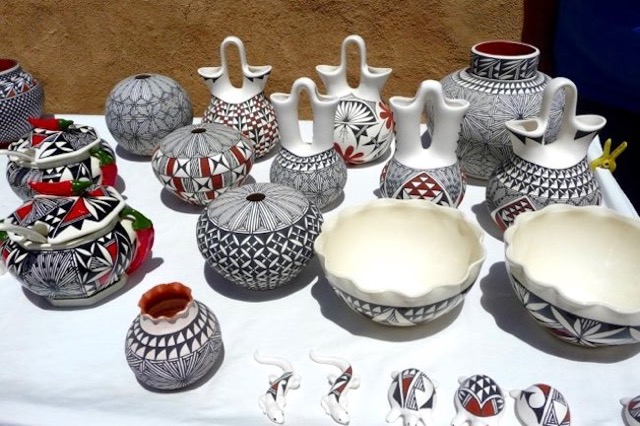
Acoma Pottery
When visitors arrive, the women of Acoma display their hand-crafted pottery on tables outside their homes. Prized by collectors, Acoma Pottery is known for its delicate thin walls and hand-painted designs.
Each design, whether geometric or nature-based, is symbolic and traditional. Bring cash or a checkbook, as only a few of the artists take credit cards. You will not want to miss out on the opportunity to buy one-of-a-kind pieces signed by the artisans. You can also buy pottery and other crafts at the gift shop in the Cultural Center below the mesa.
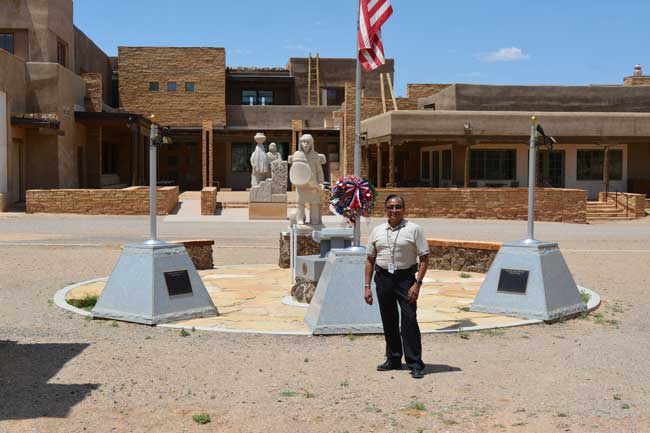
Sky City Cultural Center and Haaku Museum
One-and-a-half-hour walking tours led by Acoma tribal members are offered year-round, but times vary from the March-October schedule and the November-late March time frame. Check in and buy tickets at the modern Sky City Cultural Center at the base of the mesa.
Built in 2006, the materials, colors and design of the Cultural Center are representative of the area and Acoma people. Vans shuttle visitors up and down the road. Those who are hardy enough can choose to climb in the footsteps of the ancestors.
The Haaku Museum in the Cultural Center tells the story of the peaceful, spiritual people of Acoma and their deeply rooted traditions that have endured for 1,000 years.
Also in the Cultural Center is the wonderful Y’aak’a cafe that serves excellent lunches, both traditional Acoma and modern American dishes. The cafe is open 9 a.m. to 2:30 p.m. from March through October.
For pricing, camera permits, dress code, general tour information and annual closures, visit acomaskycity.org.
If You Go
Pueblo of Acoma
I-40, Exit 102
Acoma, NM 87034
800-747-0181
acomaskycity.org
Claudia Carbone is an award-winning journalist based in Denver, Co. She’s a frequent contributor to GoWorldTravel.com. Visit her blog Sleepin Around, a hotel and travel blog.
- Together at Sea: A Mediterranean Family Adventure - April 27, 2024
- Travel Guide to Colorado - April 26, 2024
- Travel Guide to Croatia - April 26, 2024
